
|
|
QUARC 2025 SP1 INSTALLATION GUIDE Real-Time Rapid Control Prototyping Software |

|
|
CAPTIVATE. MOTIVATE. GRADUATE.
|
© 2025 Quanser Inc., All rights reserved.
Quanser Inc.
119 Spy Court
Markham, Ontario
L3R 5H6
Canada
info@quanser.com
Phone: 1-905-940-3575
Fax: 1-905-940-3576
Printed in Markham, Ontario.
For more information on the solutions Quanser Inc. offers, please visit the web
site at:
https://www.quanser.com
All Rights Reserved
© 2025 Quanser Consulting Inc. All rights reserved. This workmay not be translated or copied in whole or in part without the written permission of the copyright holder, except under the terms of the associated software license agreement. No part of this Installation Guide may be photocopied or reproduced in any form. The use of general descriptive names, trade names, trademarks, etc. in this publication, even if the former are not especially identified, is not to be taken as a sign that such names as understood by the Trade Marks and Merchandise Marks Act, may accordingly be used freely by anyone.
Disclaimer
While every effort has been made to ensure the accuracy and completeness of all information in this document, Quanser, Inc. assumes no liability to any party for any loss or damage caused by errors or omissions or by statements of any kind in this document, its updates, supplements, or special editions. Quanser, Inc. further assumes no liability arising out of the application or use of any product or system described herein; nor any liability for incidental or consequential damages arising from the use of this document. Quanser, Inc. disclaims all warranties regarding the information contained herein, whether expressed, implied or statutory, including implied warranties of merchantability or fitness for a particular purpose. Quanser Inc. reserves the right to make changes to this document or to the products described herein without further notice.
Trademarks
QUARC is a trademark of Quanser Consulting, Inc. MATLAB, Simulink, Simulink Coder, and MATLAB Coder are registered trademarks of The MathWorks, Inc. Windows, Windows SDK, Visual Studio and Visual C++ are registered trademarks of Microsoft Corporation. DuoVero Zephyr and Verdex Pro are trademarks of Gumstix, Inc. Intel and Pentium are registered trademarks of Intel Corporation.
Other brands and their products are trademarks or registered trademarks of their respective holders and should be noted as such.
Printed in Canada
Thank you for purchasing QUARC
You should read this installation guide because:
-
QUARC is a high performance real-time process and very careful configuration is required to ensure that maximum performance is achieved.
-
Many complex programs must work together to achieve this performance and hence following this guide is critical to a successful installation.

|

|
|
| There are no shortcuts | ||
| Do not ignore this Installation Guide | ||
This Installation Guide covers the following:
-
Single-user installation and configuration for Windows
-
Network installation and configuration for Windows
The Installation should be performed by a qualified computer engineer or computer technologist, preferably with experience in the following:
-
Windows OS
-
MATLAB, Simulink, Simulink Coder, MATLAB Coder, Control System Toolbox
-
Real-time operation of PCs
Please follow the instructions provided in this Installation Guide completely and fully.
If any questions arise in the course of your installation, please contact Quanser Technical Support by completing the online form at:
www.quanser.com/support/technical-support
Or by sending email to: tech@quanser.com
QUARC ARCHITECTURE AND INSTALLATION OVERVIEW
QUARC is Quanser's state-of-the-art rapid prototyping and production system for real-time control. QUARC integrates seamlessly with Simulink to allow Simulink models to be run in real-time on a variety of targets, including 32-bit and 64-bit Windows, and various embedded platforms (please refer to the list of supported targets on the QUARC website).
QUARC Components
The following is a list of QUARC's installation components:
-
QUARC Simulink Development Environment (SDE): This component is required to generate/build code from MATLAB and Simulink models.
-
QUARC Targets: QUARC supports 32-bit and 64-bit Windows, and various embedded targets. The QUARC Target Manager runs the generated real-time code on the selected target. The target can be local (same machine as where the SDE is) or remote.
-
Quanser License Manager: Manages licenses for Quanser products.
The above list includes the QUARC "installation components". Another term that will be used extensively in the upcoming sections of this document is "installation features" and needs to be clearly distinguished from "installation components" in order to avoid confusion. During the QUARC installation process, you will be asked to select the features you wish to install in one of the installation windows. Depending on the installation type you are performing, you might have to select specific features to be installed or not installed. You should refer to the appropriate section of this document for specific instructions for each installation type.
Figure 1.1 shows a snapshot of the installation window on the host machine in which you have to select the features you would like to install (note that the feature tree of the installation window on the target machine would be slightly different). As you can see from the figure, the QUARC hierarchy tree view item is divided into Host, Targets and Quanser License Manager.
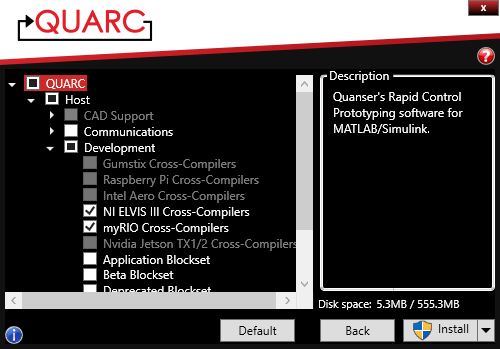
|
|
Feature Selection Window |
Note that the installation window groups different features under the hierarchy tree. Each branch is categorized for easier organization, but each leaf itself is the feature that needs to be selected for installation. The following table provides a brief summary of each feature and whether they can be installed on a host or target machine.

|
Caution: If any of the above feature becomes grey and disabled, it is either because you are not entitled to use this feature from the license or because you don't have the software required for this feature. |
Another important distinction that needs to be made to avoid possible confusion is between the terms host, target, server and client. QUARC Host is the machine on which code is generated from MATLAB/Simulink models. QUARC Target is the machine on which the generated code runs. License Server is the machine on which the Quanser License Manager is installed in a network installation. A QUARC Host and a QUARC Target may both use the License Server to configure their product licensing. Client is a machine that uses the license server to configure its licensing and may either be a host or a target as noted. Throughout this document, the terms server and client are only used to specify a server/client relationship in the licensing sense and do not indicate the host/target relationship in any means.
There are two installation modes associated with QUARC, namely single-user installation and network installation. Depending on the license type you have purchased (i.e., single-user license or network license), you must follow the respective installation instructions found in the upcoming sections of this document. However, in order to familiarize the user with both modes and their overall architecture, a brief description of each is given below.
Single-User Mode
In the single-user mode (also referred as local mode), all of the above components are installed on a single machine and both the license manager and the QUARC product itself will be configured on this machine after the installation. A detailed description of this procedure is given in the Single-User Installation sections of this document and you should follow these instructions if you have purchased a single-user license.
Network Mode
In this mode the QUARC SDE and other QUARC Target components will be installed on every client machine and only the Quanser License Manager component is installed on the license server machine. In addition after the installation has completed, the license configuration tool will be used to configure the QUARC product on client machines and the License Manager on the server machine. Again, a detailed description of this procedure will be presented in the Network Installation sections of this document and you should follow these instructions if you have purchased a network license. Please note that, it is also possible to only install the QUARC Target component on your client machines. In this case, since QUARC SDE is not installed, you will not be able to generate/build code from your Simulink models. However you can still run previously generated QUARC executable files on your intended target provided that:
-
You have met QUARC Target's software/hardware requirements. Refer to the Software Requirements and Hardware Requirements sections in this document.
-
Your intended target is included in the license you have purchased. (For example if you have only purchased the Windows Target License, you will not be able to run code on other embedded targets).
QUARC allows you to run the real-time code generated from your Simulink models on both local and remote targets. Figure 1.2 illustrates QUARC's architecture and its components when the host and target are on the same machine:
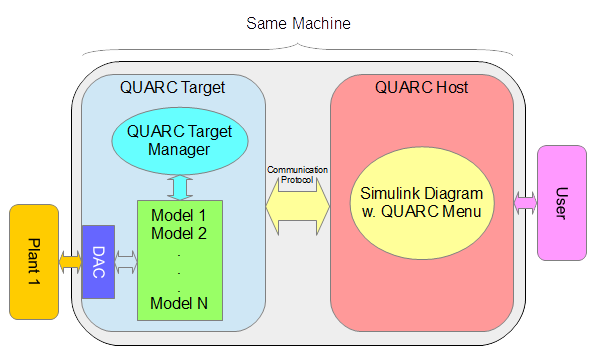
|
|
Local Configuration With QUARC Host And Target On The Same Machine |
Figure 1.3 below illustrates QUARC's architecture and its components when the code runs on a remote target (or multiple remote targets).
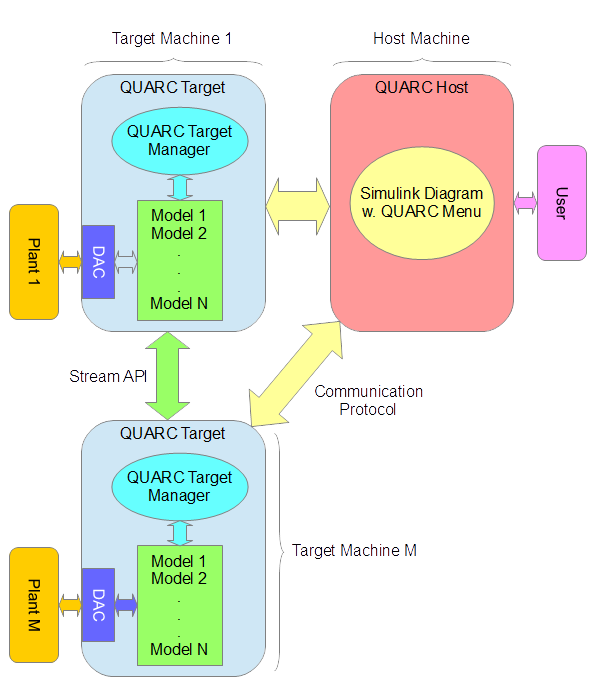
|
|
Remote Configuration With QUARC Host And Target On Different Machines |
SOFTWARE REQUIREMENTS
In this section software requirements for proper operation of each of the QUARC installation components discussed above are presented.
Host
The software requirements for the QUARC Simulink Development Environment (SDE) component running on the Windows host PC include:
-
64-bit MATLAB
-
Simulink
-
Simulink Coder
-
MATLAB Coder
-
Optional but highly recommended: Control System Toolbox. QUARC does not actually require the Control System Toolbox to operate. However, the Control System Toolbox is used by most of Quanser's controls laboratories.
* For the specific MATLAB versions supported, please refer to the QUARC Compatibility Table. There are also additional requirements for the QUARC SDE component that depend on the target type for which you need to build code. Those requirements are also listed in the compatibility table.
QUARC Targets
The software requirements for the installation of the QUARC runtime Target component depend on the target type on which you need to run the QUARC model/code:
-
QUARC Target for Windows requires Microsoft Windows 7 SP1, Microsoft Windows 10 or Microsoft Windows 11.

Caution: When running a QUARC model on a Microsoft Windows remote target, the remote target PC must have the C runtime library installed on the target e.g., msvcr140.dll. The C runtime library version must correspond to the version of the compiler used on the host to build the model e.g., Microsoft Visual C++ 2019 Redistributable.  Due to changes made by Microsoft to digital signature requirements for drivers, Windows 7 and Windows Server 2008 R2
may no longer recognize Quanser drivers as signed unless Windows updates have been applied. In particular, hotfix
KB3033929
needs to be applied to these operating systems so that they recognize SHA256 digital signatures, which are
now required by Microsoft. This hotfix should be applied automatically if required updates are
installed via Windows Update. See Appendix A for details.
Due to changes made by Microsoft to digital signature requirements for drivers, Windows 7 and Windows Server 2008 R2
may no longer recognize Quanser drivers as signed unless Windows updates have been applied. In particular, hotfix
KB3033929
needs to be applied to these operating systems so that they recognize SHA256 digital signatures, which are
now required by Microsoft. This hotfix should be applied automatically if required updates are
installed via Windows Update. See Appendix A for details.
-
For other embedded targets, please refer to the corresponding target installation guide.
Quanser License Manager
The software requirements to install the Quanser License Manager are:
-
Microsoft Windows 7 SP1, Microsoft Windows 10 or Windows 11.
-
Microsoft Windows Server 2016 or Microsoft Windows Server 2019.
-
Debian-based Linux machine, e.g., Ubuntu 22.04 LTS or later.
Compiler Configuration
This chapter describes the various compilers for Windows targets that are supported by QUARC and key details on how they should be installed and/or configured to work with QUARC.
Microsoft Visual Studio 2019 Professional/Community Edition with Visual C++
Microsoft Visual Studio 2019 Professional/Community Edition with Visual C++ can be used by versions of QUARC-supported MATLAB/Simulink indicated in the QUARC Compatibility Table.
Note that Microsoft Visual Studio 2019 Community Edition are available for free from here.
When installing Visual Studio, make sure that on the Visual Studio Installation Options page, shown in Figure 3.6 (Professional Edition) and Figure 3.7 (Community Edition), that the "Desktop development with C++" workload under "Desktop & Mobile" or "Windows" groupings is checked.

|
|
Visual Studio 2019 Professional Edition Installer Options Page |

|
|
Visual Studio 2019 Community Edition Installer Options Page |
Once Microsoft Visual Studio 2019 Professional/Community Edition with Visual C++ is installed, launch MATLAB and type:
mex -setup
in the MATLAB Command Window. Follow the instructions to select Microsoft Visual C++ 2019 as the default MATLAB compiler. This is illustrated in Figure 3.8.
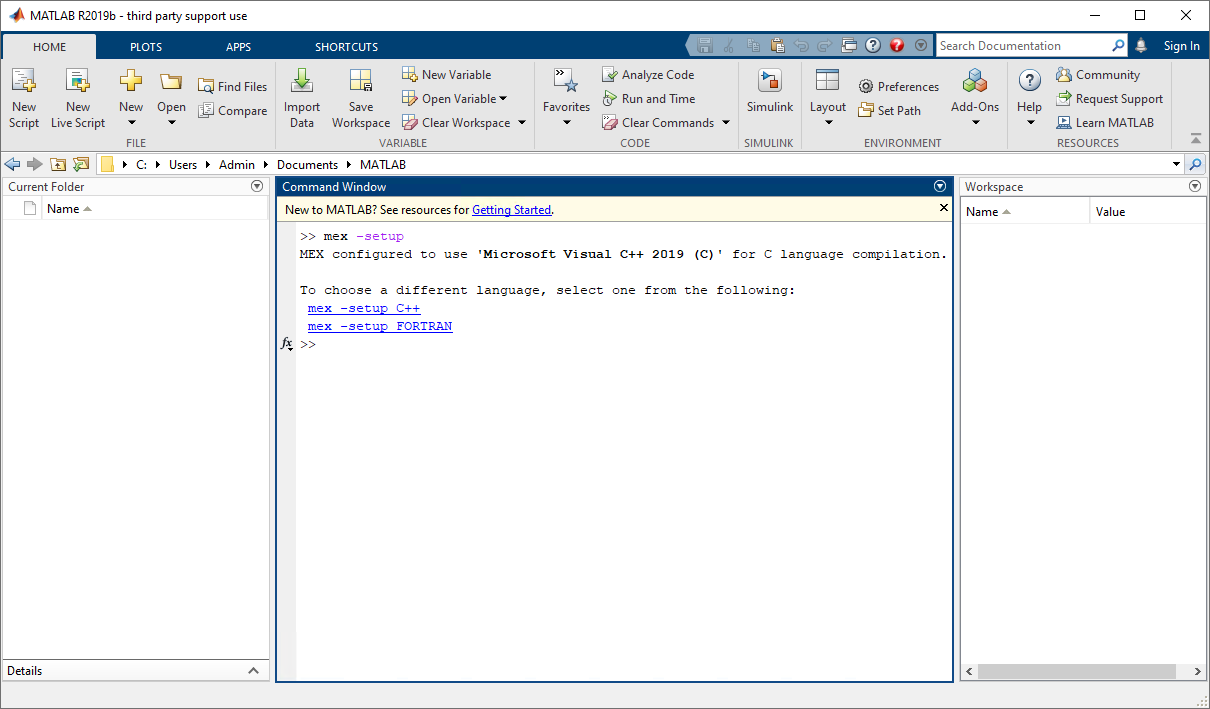
|
|
Visual C++ 2019 Compiler Selection |
Microsoft Visual Studio 2022 Professional/Community Edition with Visual C++
Microsoft Visual Studio 2022 Professional/Community Edition with Visual C++ can be used by versions of QUARC-supported MATLAB/Simulink indicated in the QUARC Compatibility Table.
Note that Microsoft Visual Studio 2022 Community Edition are available for free from here.
When installing Visual Studio, make sure that on the Visual Studio Installation Options page, shown in Figure 3.9 (Professional Edition) and Figure 3.10 (Community Edition), that the "Desktop development with C++" workload under "Desktop & Mobile" or "Windows" groupings is checked.

|
|
Visual Studio 2022 Professional Edition Installer Options Page |

|
|
Visual Studio 2022 Community Edition Installer Options Page |
Once Microsoft Visual Studio 2022 Professional/Community Edition with Visual C++ is installed, launch MATLAB and type:
mex -setup
in the MATLAB Command Window. Follow the instructions to select Microsoft Visual C++ 2022 as the default MATLAB compiler. This is illustrated in Figure 3.11.
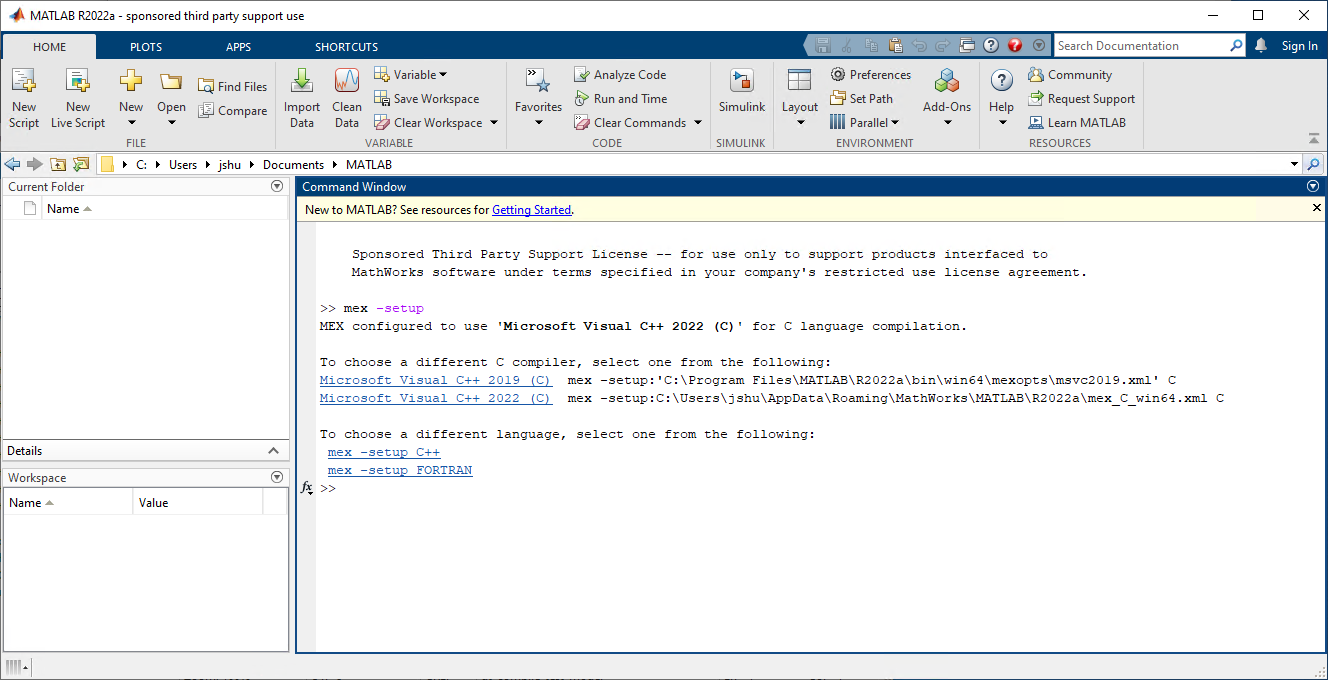
|
|
Visual C++ 2022 Compiler Selection |
Hardware Requirements
In this section hardware requirements for proper operation of the installation components discussed earlier are presented. Note that the disk space and RAM requirements listed below are only for the QUARC component being installed. The disk space and RAM requirements for any other third party software, such as MATLAB and compilers, should be obtained from their appropriate documentation and added separately.

|
Caution: QUARC will neither install nor run on any type of virtual machines. |
QUARC Windows Host
The following indicates the hardware requirements of the intended Windows host (SDE) machine.
-
Processor: An Intel, or AMD, 64-bit (x64) processor with eight logical cores.
-
RAM: 16 GB.
-
Disk Space: 10 GB.
QUARC Windows Target
The following indicates the hardware requirements of the intended Windows target machine. If the target system is the same as the host system, the QUARC SDE hardware requirements should be used.
-
Processor: Dual-core or higher Intel or AMD CPU.
-
RAM: 1 GB.
-
Disk Space: 100 MB.
Windows Setup
This chapter describes how to install QUARC and configure the QUARC license for both a single-user and network installation.
Note that the instructions in this section refer to online QUARC installation, which assumes an Internet connection exist on the setup PC. It is possible to first download QUARC and then install QUARC later. Please refer to Appendix C for more information.
Single-User
ALL software MUST be installed using the Administrator account or an account with administrator privileges. This ensures that all paths are available to all User Accounts.
Please follow these instructions if you have purchased a single-user license and would like to install QUARC on a Windows machine. If you have purchased a network license, please follow the corresponding installation instructions found in other sections of this document.

|
Caution: It is extremely important to follow the instructions in Appendix C Windows Power Management Settings to change the system power setting in order to prevent the system from losing control of the hardware. |

|
Caution: Ensure that the person installing QUARC is logged in as Administrator or has Administrator privileges. |
To check privileges for a user, click on Start, then type Computer Management and select it. Under Computer Management, in the System Tools section, expand Local Users and Groups and open the Groups section. Then double-click on the Administrators name and see if the login name that you are using is displayed (with the correct domain name, if applicable) in the Members list. If your username is not displayed in the list, then you do not have Administrator privileges. If the Administrators group does not appear, then you do not have Administrator privileges. Even if you are logged in as Administrator, it may still prompt you to elevate your privileges to full Administrator privileges when you run the Configure Licensing tool.

|
Caution: Ensure that the version of QUARC that you are planning to install is compatible with your QUARC license file. The installer itself will check compatibility. Also make sure the license file is located on the same drive as where you're planning to install QUARC. |
To check the QUARC license manually, open the QUARC license file. This is a text
file (with a .qlic file extension) that can be opened, for example, with Wordpad.
The version of QUARC that you are planning to install should be included within
the version range indicated by the Minimum version: and Maximum version:
fields of the QUARC license file.

|
Caution: If you already have an earlier version of QUARC installed on your machine it must be removed prior to installing the newer version. Furthermore, if you have the QUBE-SERVO-USB, Q2-USB, or Q8-USB devices, you need to unplug them from the computer before uninstalling the earlier version of QUARC. |
In order to uninstall an earlier installation of QUARC please follow the Remove instructions in Section 7.
It should be mentioned that the appropriate version of MATLAB should be installed
prior to installing QUARC, since QUARC automatically adds itself to the MATLAB path.
However it is also possible to add QUARC manually to the MATLAB path if QUARC is
installed prior to installing MATLAB. This can be done by running the quarc_setup
script found in %QUARC_DIR%\quarc, where
%QUARC_DIR% denotes the installation directory of QUARC (typically
C:\Program Files\Quanser\QUARC).

|
Caution: If you have already installed the Quanser HIL SDK or Quanser SDK, you should remove it before installing QUARC. QUARC contains the complete Quanser SDK and conflicts can arise if an incompatible version of the HIL SDK or Quanser SDK is installed at the same time as QUARC. |
Make sure MATLAB and Microsoft Visual Studio are closed before beginning the installation.
Turn off any antivirus software prior to installing QUARC. Your antivirus software can be turned back on at the end of this Section, once the QUARC installation is complete.
The QUARC installation steps are as follows:
-
Download the QUARC web installer executable using the link provided in the confirmation email that you received.
-
Run the QUARC web installer install_quarc.exe.
-
The installer window should show up and start the installation process. First it will go online to check if there is a newer version available for you to update, as shown in Figure 5.1. Therefore we highly recommend having an Internet connection during installation.
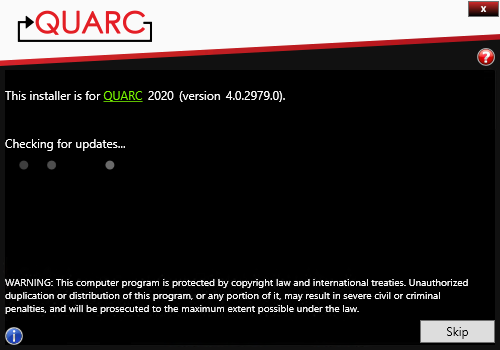
Checking for Updates

Caution: Check tips for each installation window by hovering the mouse cursor over the blue information icon on the lower left corner or click the question mark icon on the upper right corner for more details, as shown in Figure 5.2. 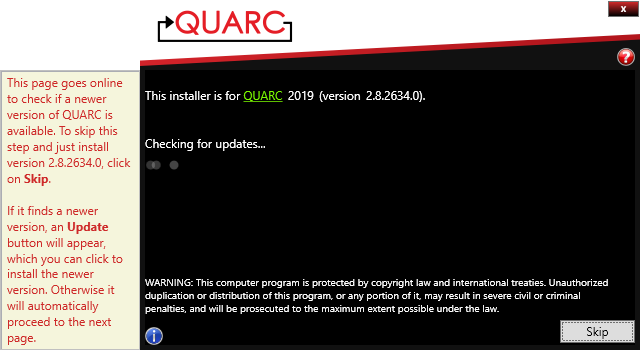
Tips
-
The installer will notify you if there is a newer version available as shown in Figure 5.3. Either click Update to have the newer version installed or click Skip to keep your current version.
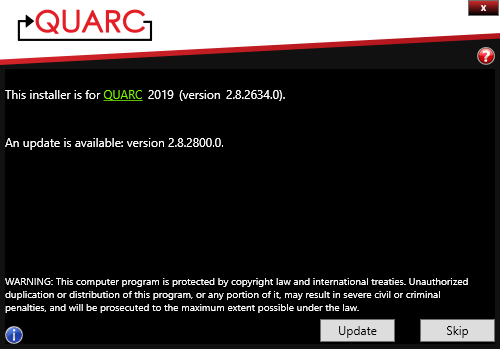
New Update Available
-
The next page is the License Agreement page, as illustrated in Figure 5.4. To install QUARC, please click "I Agree" to continue.
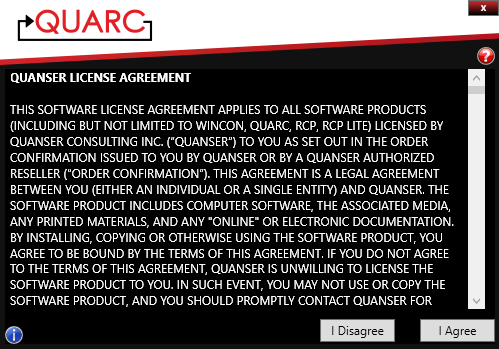
License Agreement Page
-
Figure 5.5 will then show up for you to provide the license file from Quanser. Click "Next" button to continue.
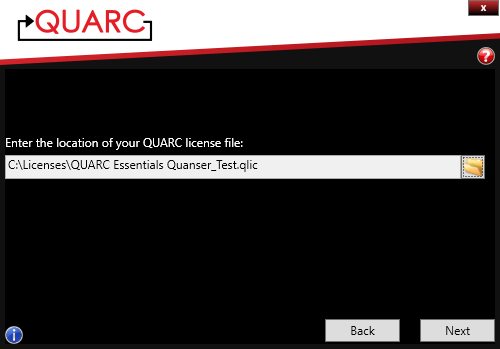
License File Page
-
As shown in Figure 5.6, the installer will perform a compatibility check before starting the installation. This check scans your PC to ensure the required software is present. Please refer to the Compatibility Table for more details. Click "Install" button to install QUARC using the default settings, or click "Options" to customize.
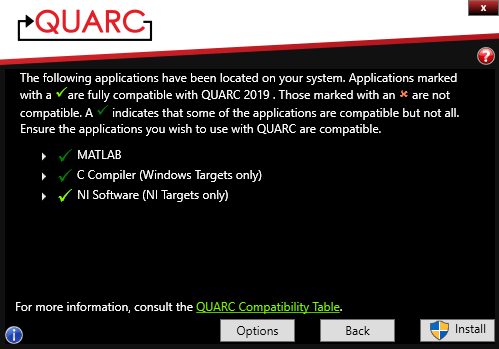
Compatibility Checking
Note that the C compiler versions are verified against the installed MATLAB versions on the host PC. Hence, a C compiler version will be marked as incompatible if it is not supported by any of the MATLAB versions installed.
Note that depending on the intended targets that you want to use, you might not need to have all the optional software installed. For example, if you do not intend to use NI targets (e.g. myRIO or ELVIS III), you can continue installing QUARC even without NI Software.
-
If "Options" is clicked, provide the destination folder where QUARC will be installed in the Figure 5.7 window and click "Next" to continue.
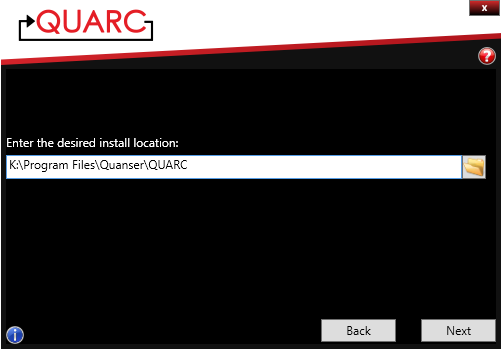
Installation Location Page

Caution: If the desired install location is not on the system drive (normally C:), it is recommended to enable short path name support. Refer to Appendix D for more information. -
Please refer to the Important Notes below before configuring the features on the Feature Selection page depicted in Figure 5.8.

Feature Selection Page
Important Notes:
-
The features are automatically selected based on the license file you provided to the installer.
-
If you are not licensed for a feature, the feature will be disabled and grey in the tree hierarchy.
-
If you don't have the software required by a feature, the feature will be disabled and grey in the tree hierarchy.
-
In order to use QUARC with certain embedded targets, the appropriate Cross-Compilers feature must be installed (please refer to the corresponding product installation guide).
-
QUARC provides a variety of external interfaces or APIs with which the user can communicate with the real-time code or access hardware. In order to use these external interfaces, the appropriate features must be selected.
The following summarizes the feature that is required for each supported external interfaces:
-
-
.NET:

.NET Feature Selection Page
-
Java:
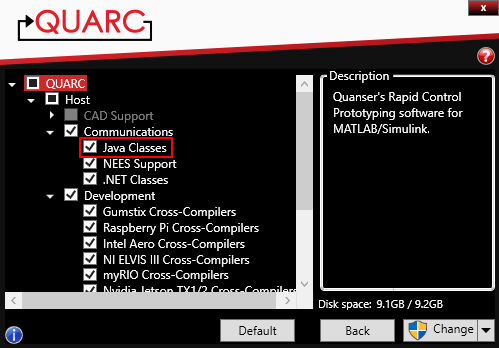
Java Feature Selection Page
-
Python:
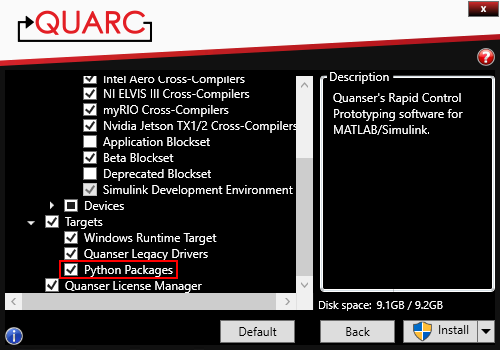
Python Feature Selection Page
-
As mentioned earlier in this document, the Simulink Development Environment component is required to generate/build the real-time code to be run on a selected target. It should be noted that if you select to install the QUARC Target for Windows component, but not to install QUARC SDE, you will not be able to generate/build code from your Simulink models. However you can still run previously generated QUARC executable files on your intended target provided that:
-
The QUARC Target's software/hardware requirements discussed earlier have been met.
-
The intended target is included in the license purchased. For example if you have only purchased the QUARC Target for Windows License, you will not be able to run code on other embedded targets.
-
-
Since you have purchased a single-user license, please install QUARC and Quanser License Manager on the same computer. In the Feature Selection window, make sure that QUARC and Quanser License Manager are both selected to be installed.
-
Click "Install" to start the installation process. During the installation, there will be video clips introducing QUARC and its functionalities as shown in Figure 5.12. You can pause, resume or replay the video as well as adjust the volume by using the toolbar that appears when the mouse is moved over the video.
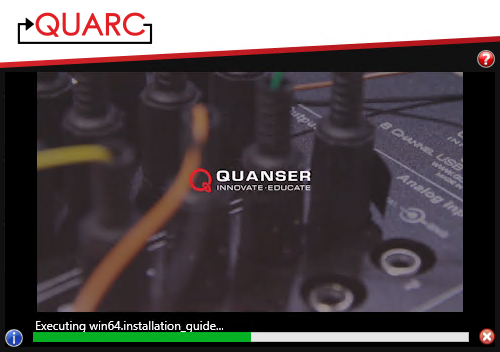
|
|
Installation Progress Page |
-
Once the installation is complete, you can click the links on Figure 5.13, or click "Close" to finish the installation.
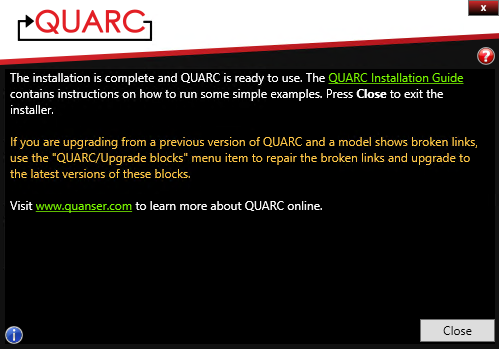
Installation Finished Page
Important Note: To resolve any possible broken links in the Simulink diagram that might be caused by upgrading from an earlier version of QUARC, please use the "Upgrade blocks" option in the QUARC "Utilities" menu. To do this, simply select the QUARC Simulink Toolstrip, click on the "Utilities" menu item of the Simulink model and select "Upgrade blocks". Please refer to the "Upgrading QUARC" section in QUARC documentation for more information on this issue.
Network
ALL software MUST be installed using the Administrator account or an account with administrator privileges. This ensures that all paths are available to all User Accounts.
Please follow these instructions if you have purchased a network license and would like to install QUARC on a Windows machine. If you have purchased a single-user license, please follow the corresponding installation instructions found in other sections of this document.

|
Caution: It is extremely important to follow the instructions in Appendix C Windows Power Management Settings to change the system power setting in order to prevent the system from losing control of the hardware. |

|
Caution: Ensure that the person installing QUARC is logged in as Administrator or has Administrator privileges. |
To check privileges for a user, click on Start, then type Computer Management and select it. Under Computer Management, in the System Tools section, expand Local Users and Groups and open the Groups section. Then double-click on the Administrators name and see if the login name that you are using is displayed (with the correct domain name, if applicable) in the Members list. If your username is not displayed in the list, then you do not have Administrator privileges. If the Administrators group does not appear, then you do not have Administrator privileges. Even if you are logged in as Administrator, it may still prompt you to elevate your privileges to full Administrator privileges when you run the Configure Licensing tool.

|
Caution: Ensure that the version of QUARC that you are planning to install is compatible with your QUARC license file. The installer itself will check compatibility. Also make sure the license file is located on the same drive as where you're planning to install QUARC. |
To check the QUARC license manually, open the QUARC license file. This is a text
file (with a .qlic file extension) that can be opened, for example, with Wordpad.
The version of QUARC that you are planning to install should be included within
the version range indicated by the Minimum version: and Maximum version:
fields of the QUARC license file.

|
Caution: If you already have an earlier version of QUARC installed on your machine it must be removed prior to installing the newer version. Furthermore, if you have the QUBE-SERVO-USB, Q2-USB, or Q8-USB devices, you need to unplug them from the computer before uninstalling the earlier versions of QUARC. |
In order to uninstall an earlier installation of QUARC please follow the Remove instructions in Section 6.
It should be mentioned that the appropriate version of MATLAB should be installed
prior to installing QUARC, since QUARC automatically adds itself to the MATLAB path.
However it is also possible to add QUARC manually to the MATLAB path if QUARC is
installed prior to installing MATLAB. This can be done by running the quarc_setup
script found in %QUARC_DIR%\quarc, where
%QUARC_DIR% denotes the installation directory of QUARC (typically
C:\Program Files\Quanser\QUARC).

|
Caution: If you have already installed the Quanser HIL SDK or Quanser SDK, you should remove it before installing QUARC. QUARC contains the complete Quanser SDK and conflicts can arise if an incompatible version of the HIL SDK or Quanser SDK is installed at the same time as QUARC. |
The network licensing setup consists of two separate installations using two different QUARC license files. Please install the Quanser License Manager on the License server machine using the "{UserName} Network-Server.qlic" QUARC license file, and only the QUARC SDE and/or Windows Target components on every client machine on the network using the "{UserName} Network-Client.qlic" QUARC license file. There are also separate procedures for configuring the license on the server and client machines which will be outlined in this section.
License Server
To install the Quanser License Manager on the license server machine follow the instructions listed below. Also ensure that MATLAB and Microsoft Visual Studio are closed before beginning the installation.
-
Download the QUARC web installer executable using the link provided in the confirmation email that you received.
-
Run the QUARC web installer install_quarc.exe.
-
The installer window should show up and start the installation process. First it will go online to check if there is a newer version available for you to update, as shown in Figure 5.14. Therefore we highly recommend having an Internet connection during installation.

Checking for Updates

Caution: Check tips for each installation window by hovering the mouse cursor over the blue information icon on the lower left corner or click the question mark icon on the upper right corner for more details, as shown in Figure 5.15. 
Tips
-
The installer will notify you if there is a newer version available as shown in Figure 5.16. Either click Update to have the newer version installed or click Skip to keep your current version.

New Update Available
-
The next page is the License Agreement page, as illustrated in Figure 5.17. To install QUARC, please click "I Agree" to continue.

License Agreement Page
-
Figure 5.18 will then show up for you to provide the license file from Quanser. Since you are using a network license, the installer will ask you to provide license server information. Be sure to set the host name or IP address to
localhostand the port to the desired port. The default port used by the Quanser License Manager is port 16999, and is the recommended value.Click "Next" button to continue.

Caution: If the License Server computer is equipped with a Firewall, please ensure that the port (by default: 16999) configured to be used by the Quanser License Manager is allowed (i.e., not blocked) by the active Firewall. 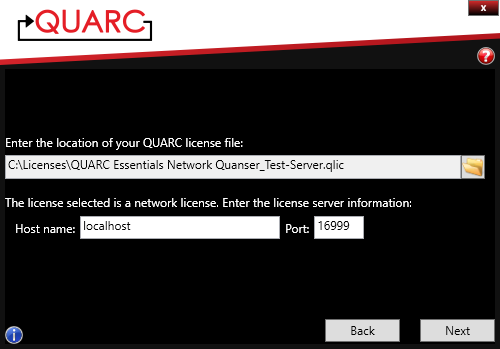
License File Page
-
As shown in Figure 5.19, the installer will perform a compatibility check before starting the installation. This check scans your PC to ensure the required software is present. Please refer to the Compatibility Table for more details. Use the dropdown button next to "Install" and select "License Server" to install Quanser License Manager using the default settings, or click "Options" to customize.
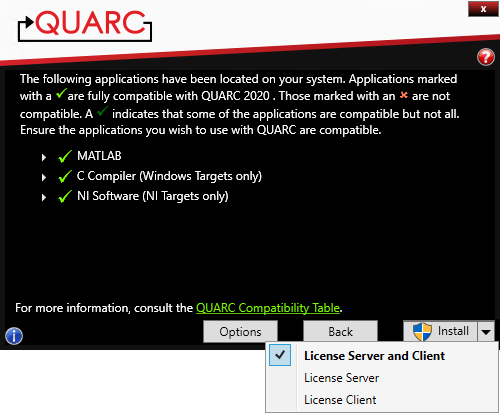
Compatibility Checking
Because you're installing the License Server, none of the required and optional software are needed. So you can simply ignore any missing software on this page.
-
If "Options" is clicked, provide the destination folder where QUARC will be installed in the Figure 5.20 window and click "Next" to continue.

Installation Location Page

Caution: If the desired install location is not on the system drive (normally C:), it is recommended to enable short path name support. Refer to Appendix D for more information. -
Use the dropdown button next to "Default" and select "License Server" to select the Quanser License Manager only as illustrated in Figure 5.21. It is not necessary to install any other features on the license server.
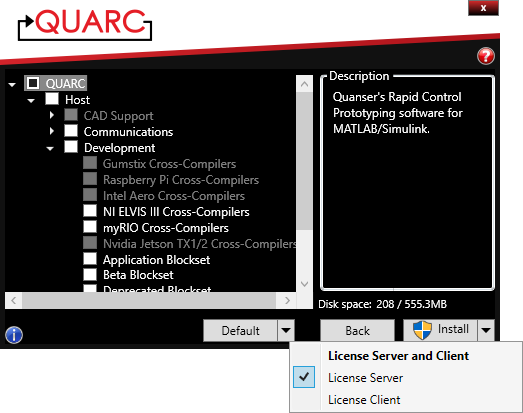
Feature Selection Page
-
Click "Install" to start the installation process. During the installation, there will be video clips introducing QUARC and its functionalities as shown in Figure 5.22. You can pause, resume or replay the video as well as adjust the volume by using the toolbar that appears when the mouse is moved over the video.

Installation Progress Page
-
Once the installation is complete, you can click the links on Figure 5.23, or click "Close" to finish the installation.

Installation Finished Page
License Client
There are different instructions on how to install QUARC and configure the license on client machines, which follow next.
Make sure MATLAB and Microsoft Visual Studio are both closed before beginning the installation.
Turn off any antivirus software prior to installing QUARC. Your antivirus software can be turned back on at the end of this Section, once the QUARC installation is complete.
Please perform the following installation steps for each client machine on the network:
-
Download the QUARC web installer executable using the link provided in the confirmation email that you received.
-
Run the QUARC web installer install_quarc.exe.
-
The installer window should show up and start the installation process. First it will go online to check if there is a newer version available for you to update, as shown in Figure 5.24. Therefore we highly recommend having an Internet connection during installation.

Checking for Updates

Caution: Check tips for each installation window by hovering the mouse cursor over the blue information icon on the lower left corner or click the question mark icon on the upper right corner for more details, as shown in Figure 5.25. 
Tips
-
The installer will notify you if there is a newer version available as shown in Figure 5.26. Either click Update to have the newer version installed or click Skip to keep your current version.

New Update Available
-
Click the Next button to see the License Agreement page, as illustrated in Figure 5.27. To install QUARC, please click "I Agree" to continue.

License Agreement Page
-
Figure 5.28 will then show up for you to provide the license file from Quanser. Since you are using a network license, the installer will ask you to provide license server information. Be sure to set the host name or IP address to the location of the license server and the port. The default port used by the Quanser License Manager is port 16999.
Click "Next" button to continue.

Caution: If the License Server computer is equipped with a Firewall, please ensure that the port (by default: 16999) configured to be used by the Quanser License Manager is allowed (i.e., not blocked) by the active Firewall. 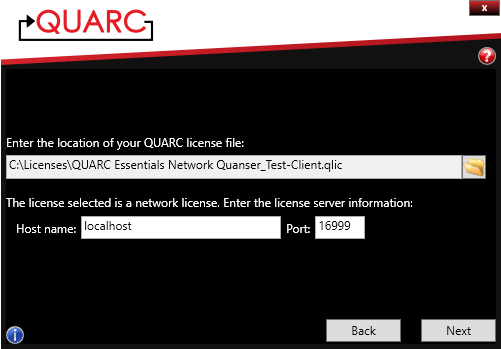
License File Page
-
As shown in Figure 5.29, the installer will perform a compatibility check before starting the installation. This check scans your PC to ensure the required software is present. Please refer to the Compatibility Table for more details. Use the dropdown button next to "Install" and select "License Client" to install QUARC using the default settings for a license client (Quanser License Manager not installed), or click "Options" to customize.

Compatibility Checking
Note that the C compiler versions are verified against the installed MATLAB versions on the host PC. Hence, a C compiler version will be marked as incompatible if it is not supported by any of the MATLAB versions installed.
Note that depending on the intended targets that you want to use, you might not need to have all the optional software installed. For example, if you do not intend to use NI targets (e.g. myRIO or ELVIS III), you can continue installing QUARC even without NI Software.
-
If "Options" is clicked, provide the destination folder where QUARC will be installed in the Figure 5.30 window and click "Next" to continue.

Installation Location Page

Caution: If the desired install location is not on the system drive (normally C:), it is recommended to enable short path name support. Refer to Appendix D for more information. -
Please refer to the Important Notes below before configuring the features on the Feature Selection page depicted in Figure 5.31.
Use the dropdown button next to "Default" and select "License Client" to select the typical QUARC features for which you are licensed (but not the Quanser License Manager).
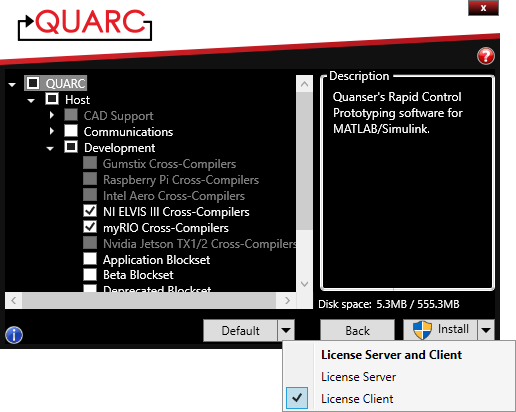
Feature Selection Page
Important Notes:
-
The features are automatically selected based on the license file you provided to the installer.
-
If you are not licensed for a feature, the feature will be disabled and grey in the tree hierarchy.
-
If you don't have the software required by a feature, the feature will be disabled and grey in the tree hierarchy.
-
In order to use QUARC with certain embedded targets, the appropriate Cross-Compilers feature must be installed (please refer to the corresponding product installation guide).
-
-
As mentioned earlier in this document, the Simulink Development Environment component is required to generate/build the real-time code to be run on a selected target. It should be noted that if you select to install the QUARC Target for Windows component, but not to install QUARC SDE, you will not be able to generate/build code from your Simulink models. However you can still run previously generated QUARC executable files on your intended target provided that:
-
The QUARC Target's software/hardware requirements discussed earlier have been met.
-
The intended target is included in the license purchased. For example if you have only purchased the QUARC Target for Windows License, you will not be able to run code on other target types.
-
-
Click "Install" to start the installation process. During the installation, there will be video clips introducing QUARC and its functionalities as shown in Figure 5.32. You can pause, resume or replay the video as well as adjust the volume by using the toolbar that appears when the mouse is moved over the video.

Installation Progress Page
-
Once the installation is complete, you can click the links on Figure 5.33, or click "Close" to finish the installation.

Installation Finished Page
Important Note: To resolve any possible broken links in the Simulink diagram that might be caused by upgrading from an earlier version of QUARC, please use the "Upgrade blocks" option in the QUARC "Utilities" menu. To do this, simply select the QUARC Simulink Toolstrip, click on the "Utilities" menu item of the Simulink model and select "Upgrade blocks". Please refer to the "Upgrading QUARC" section in QUARC documentation for more information on this issue.
Quiet Installation
ALL software MUST be installed using the Administrator account or an account with administrator privileges. This ensures that all paths are available to all User Accounts.
QUARC provides a quiet installation option for system administrators who need to install QUARC on multiple machines without the need for user interactions. This works for both single-user or network setups. The quiet installation option makes use of the licensed features in the license file when selecting which features to be installed. If you want to have full control of the features to be installed, please follow the single-user or network installation instructions found in other sections of this document.

|
Caution: It is extremely important to follow the instructions in Appendix C Windows Power Management Settings to change the system power setting in order to prevent the system from losing control of the hardware. |

|
Caution: Ensure that the person installing QUARC is logged in as Administrator or has Administrator privileges. |
To check privileges for a user, click on Start, then type Computer Management and select it. Under Computer Management, in the System Tools section, expand Local Users and Groups and open the Groups section. Then double-click on the Administrators name and see if the login name that you are using is displayed (with the correct domain name, if applicable) in the Members list. If your username is not displayed in the list, then you do not have Administrator privileges. If the Administrators group does not appear, then you do not have Administrator privileges. Even if you are logged in as Administrator, it may still prompt you to elevate your privileges to full Administrator privileges when you run the Configure Licensing tool.

|
Caution: Ensure that the version of QUARC that you are planning to install is compatible with your QUARC license file. The installer itself will check compatibility. Also make sure the license file is located on the same drive as where you're planning to install QUARC. |
To check the QUARC license manually, open the QUARC license file. This is a text
file (with a .qlic file extension) that can be opened, for example, with Wordpad.
The version of QUARC that you are planning to install should be included within
the version range indicated by the Minimum version: and Maximum version:
fields of the QUARC license file.

|
Caution: If you already have an earlier version of QUARC installed on your machine it must be removed prior to installing the newer version. Furthermore, if you have the QUBE-SERVO-USB, Q2-USB, or Q8-USB devices, you need to unplug them from the computer before uninstalling the earlier versions of QUARC. |
In order to uninstall an earlier installation of QUARC please follow the Remove instructions in Section 6.
It should be mentioned that the appropriate version of MATLAB should be installed
prior to installing QUARC, since QUARC automatically adds itself to the MATLAB path.
However it is also possible to add QUARC manually to the MATLAB path if QUARC is
installed prior to installing MATLAB. This can be done by running the quarc_setup
script found in %QUARC_DIR%\quarc, where
%QUARC_DIR% denotes the installation directory of QUARC (typically
C:\Program Files\Quanser\QUARC).

|
Caution: If you have already installed the Quanser HIL SDK or Quanser SDK, you should remove it before installing QUARC. QUARC contains the complete Quanser SDK and conflicts can arise if an incompatible version of the HIL SDK or Quanser SDK is installed at the same time as QUARC. |
Make sure MATLAB and Microsoft Visual Studio are closed before beginning the installation.
Turn off any antivirus software prior to installing QUARC. Your antivirus software can be turned back on at the end of this Section, once the QUARC installation is complete.
The QUARC installation steps are as follows:
-
Download the QUARC web installer executable using the link provided in the confirmation email that you received.
-
Locate the license file that you receive from Quanser. You'll need to provide the full path of the license file to install QUARC silently. It is recommended that you put the license file in the same directory as the QUARC web installer install_quarc.exe.
-
Open a command prompt as an Administrator. You can do so by right-clicking the command prompt icon on the taskbar and choose "Run as Administrator". The User Account Control window would popup, click "Yes" to allow the command prompt to be opened.
-
In the resulting command prompt, change to the directory where the QUARC web installer install_quarc.exe is located, and type the following (assuming the license file is called license.qlic, modify the license filename accordingly if it's different):
install_quarc.exe /passive LICENSEFILE="license.qlic"-
It is highly recommended to use the
/passiveflag to perform silent install, as this would still ensure that no more user ineraction is needed during installation, but the progress of the installation would still be visible. However, if you really want no visibility of the installation, you can replace the/passiveflag with/q. However in doing so, you would need to monitor the Task Manager in order to see when the QUARC installer is finished.
-
-
The QUARC installation progress window would show up, giving you an indication of the QUARC installation has started. When the installation is finished, the installation finished window would show up, as shown Figure 5.34. Click "Close" to finish the installation.

Installation Finished Page
Linux Setup
This chapter describes how to install and configure the Quanser License Manager during a QUARC network licensing installation.
Note that the instructions in this section refer to an online installation, which assumes an Internet connection exists on the machine being set up.
Network
All software MUST be installed using an account with access to
elevated privileges, e.g., to be able to run the sudo command.
Please follow these instructions if you have purchased a QUARC network license and would like to install the Quanser License Manager on a Debian-based Linux machine (e.g., Ubuntu).
The network licensing setup consists of two separate installations using two different QUARC license files.
First, please only install the Quanser License Manager on the license server machine using
the "{UserName}-Server.qlic" QUARC license file.
Then, the QUARC SDE and/or Windows Target components can be installed and configured
on every client license machine on the network
using the "{UserName}-Client.qlic" QUARC license file.
There are also separate procedures for configuring the license on the server and client machines, as outlined in this chapter.
License Server
To install and set up the latest Quanser License Manager on the license server machine follow the instructions listed below.
-
Download and run the Quanser License Manager Debian installation package, by executing the following commands:
wget --no-cache https://repo.quanser.com/debian/release/config/configure_repo.shchmod u+x configure_repo.sh./configure_repo.shrm -f ./configure_repo.shsudo apt updatesudo apt-get install quanser-license-manager -
For convenience when running the next command, it is recommended to move your received QUARC license server file (i.e.,
*-Server.qlic) over to your current working directory and rename it to “license.qlic”. -
In order to configure the machine as your QUARC license server, run the following command:
sudo quanser_license_registration -m -c -f license.qlic -n localhost -p 16999 QUARCSince you are using a network license, the
quanser_license_registrationutility requires the license server information. Be sure to set the host name or IP address tolocalhostand the port to your desired port number. The default port used by the Quanser License Manager is port16999, and is the recommended value. -
Review the settings of any active firewall.

Caution: If the license server machine is equipped with a firewall, please ensure that the port number (by default: 16999) configured to be used by the Quanser License Manager is allowed (i.e., not blocked) by the active firewall.
License Client
Only Windows QUARC license client machines are currently supported. To install and configure QUARC on each one of them, refer to the instructions described in the Windows Network License Client section.
Change, Repair, or Remove QUARC
This chapter describes how to modify an existing QUARC installation, once QUARC has been installed as described in the previous chapters.
To make modifications to an existing QUARC installation, click on the Windows Start menu, and then type Add or remove programs and select it. In the list of installed applications, look for QUARC and click on the ... button, and select Modify.
A dialog window similar to the one displayed in Figure 6.1 will show up and allow a choice between Change, Repair, or Remove as the operation on the QUARC installation.
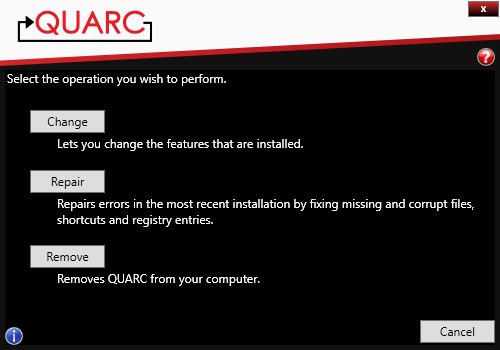
|
|
Modifying existing QUARC installation |
Change allows you to change the QUARC license file and/or the QUARC features to be installed. This is useful, for example, if you purchased a new and upgraded license (that entitles you to more features than your existing license) and need to update your QUARC installation with the new features (as well as register the new license).
Repair should be used to repair the QUARC installation if it became corrupted (e.g., accidental deletion/modification of QUARC files).
Remove uninstalls the current QUARC installation.
Testing QUARC
QUARC comes with example models that can be accessed by typing
qc_show_examples
in the MATLAB command prompt window.
The QUARC Sine & Scope Demo in particular is a test that everyone is encouraged to run. It is universal, meaning that it is not dependant on the hardware type you are using (e.g., data acquisition card). However running this test can ensure that correct installation and configuration has been done for QUARC while familiarizing first time users with basic QUARC operation principles. To run this test type:
qc_show_examples
in the MATLAB command prompt and click on "QUARC Sine & Scope Demo", which can be found under Basic Features and follow the instructions. The demo window is depicted in Figure 7.1.

|
|
Running the QUARC Sine Scope Demo in MATLAB |
There are more demos available on this page that might require specific hardware, such as Quanser's Q2-USB or Q8-USB HIL boards. You are encouraged to run these demos as well provided that the required hardware is present.
Be sure to check out the other examples as well, since they highlight many useful features of QUARC!
Troubleshooting
Review the following recommendations before contacting Quanser's technical support engineers.
Licensing Errors
Getting an 'Error configuring license' message from the Configure Licensing tool.
-
Open the Quanser-provided QUARC license file with Microsoft WordPad.
-
Ensure your QUARC version is included within the range indicated by the license file Minimum version: and Maximum version: fields.
-
Close Microsoft WordPad.
-
From the Windows Start menu, browse to the All Programs/Quanser/QUARC sub-menu and run the Configure Licensing tool using a QUARC license file, valid for your version of QUARC.
The QUARC license file has been registered successfully, but you get a 'Error configuring license' message when trying to run a QUARC model.
-
Run the QUARC Sine and Scope Demo, as described in Section 7.
-
If the QUARC Sine and Scope Demo runs as expected, then your QUARC license file does not allow some of the features used by your QUARC model. Contact Quanser's technical support for further information.
-
Otherwise, if the same error message remains, first disable any antivirus software and Windows Firewall. Then browse to the Start/All Programs/Quanser/QUARC menu and run the Configure Licensing tool, using a valid QUARC license file.
Building Errors
Getting an error when trying to build the QUARC Sine and Scope Demo
-
Type
verin the MATLAB Command Window. QUARC should appear in the displayed list. -
Depending on the compiler used, refer to Section 3 and review your compiler installation steps.
-
Run
mex -setupin the MATLAB Command Window, as described in Section 3. -
If the following error message is received when the current user is a non-administrator:
...: fatal error C1083: Cannot open include file: "...": No such file or directory
Ensure the non-admin account has read access to the registry (it might require your institution's IT department to enable that).
Getting an error when the model is being downloaded
If the following error message is received:
??? Model ... failed to download to target 'shmem://quarc-target:1'. The code being downloaded or run is not compatible with the type of target referenced by the target URI. For example, 32-bit code cannot be downloaded to a 64-bit target or vice-versa. In Simulink, make sure the system target file selected in the model's active configuration is compatible with the target referred to by the target URI.
then attempt to resolve the problem using the following steps:
-
Select the QUARC/Options... menu item from the QUARC diagram.
-
Under Code Generation, click on the Browse... button.
-
Select the system target file corresponding to your target computer (e.g., QUARC Win64 Target).
-
Click on the OK buttons to close the dialogs, and save the diagram.
Runtime Errors
Getting an error about a card or driver not being installed
If the following error is received when attempting to run a model:
Error occurred while executing External Mode MEX-file 'quarc comm': An operating system specific kernel-level driver for the specified card could not be found. The card or driver may not be installed.
then attempt to resolve the error using the following procedure:
-
If using a USB device, ensure the USB cable is properly connected, and try a different USB port on the computer.
-
Verify the data acquisition device is properly connected to the computer.
-
If this is a National Instruments (NI) data acquisition device, ensure the NI DAQmx drivers are installed. The NI DAQmx installer is on a DVD that comes with the NI hardware; it can also be downloaded from http://www.ni.com/drivers/.
-
Verify that the card shows up in Device Manager. If the card indicates that there is an error with the driver, and the operating system is Windows 7 or Windows Server 2008 R2, then it may be necessary to install hotfix KB3033929. Microsoft has changed the requirements for driver signing to enforce SHA256 digital signatures. For Windows 7 and Windows 2008 R2 to recognize drivers signed with these digital signatures, the hotfix must be applied. This hotfix should be applied automatically if required updates are installed via Windows Update.
Appendices
The appendices contain detailed information concerning topics that are peripheral to the installation of QUARC, but helpful during the installation process.
Driver Publisher Message
 On Windows 7 or Windows Server 2008 R2, the operating system may not be able to verify
that Quanser is the publisher of the driver. In this case, the dialog shown below is
displayed. This dialog indicates that the operating system is missing the hotfix that
allows SHA256 digital signatures to be recognized, which are now required by Microsoft.
The Microsoft hotfix required to resolve this issue is
KB3033929.
This hotfix should be applied automatically if required updates are installed via Windows Update.
On Windows 7 or Windows Server 2008 R2, the operating system may not be able to verify
that Quanser is the publisher of the driver. In this case, the dialog shown below is
displayed. This dialog indicates that the operating system is missing the hotfix that
allows SHA256 digital signatures to be recognized, which are now required by Microsoft.
The Microsoft hotfix required to resolve this issue is
KB3033929.
This hotfix should be applied automatically if required updates are installed via Windows Update.
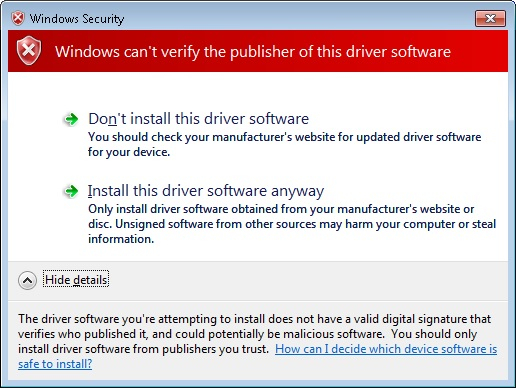
Power Management

|
Caution: It is very important to change the default settings of the Power Management software on Windows to prevent the system from sleeping. Otherwise, when the system wakes up from hibernation, the hardware may not be initialized appropriately and cause damage to your hardware and experiment. |
Please follow the next steps to disable system hibernation on Windows.
-
Goto Control Panel->Power Options, and click "Change plan settings" corresponding to your current power plan. In our case, it's "Balanced", as shown in Figure B.1.
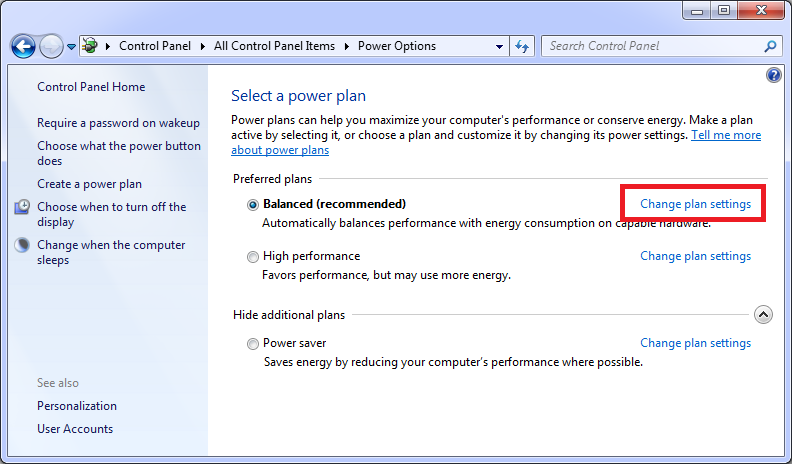
Power Option Setting Window
-
The system will bring you the "Edit Plan Settings" window. In this window, you need to set both "Turn off the display" and "Put the computer to sleep" options to "Never" as shown in Figure B.2 and Figure B.3.
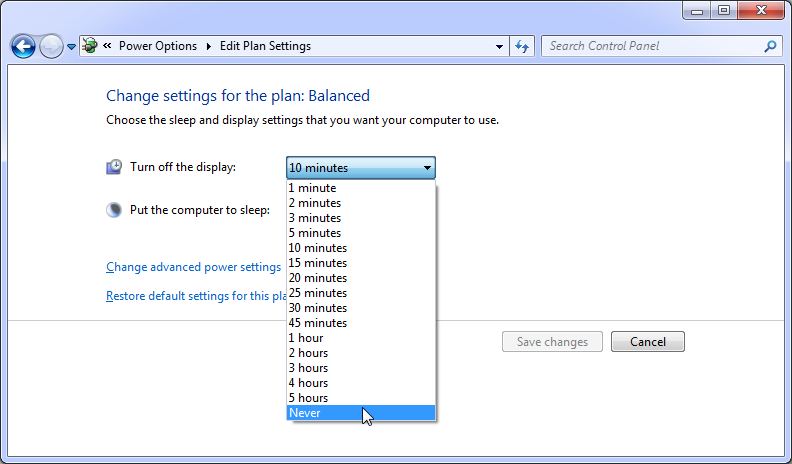
Power Option Setting Window 1
-
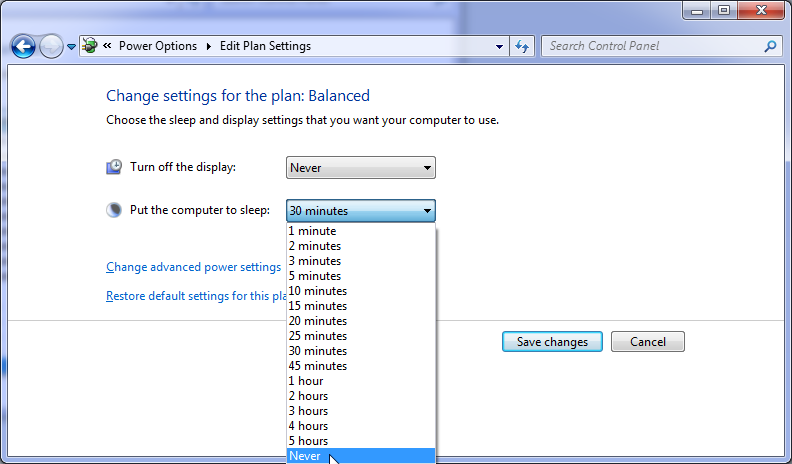
Power Option Setting Window 2
-
You need to first click "Save changes" to make the make the changes effective, then use "Change advanced power settings" option to do some more detailed changes as illustrated in Figure B.4.
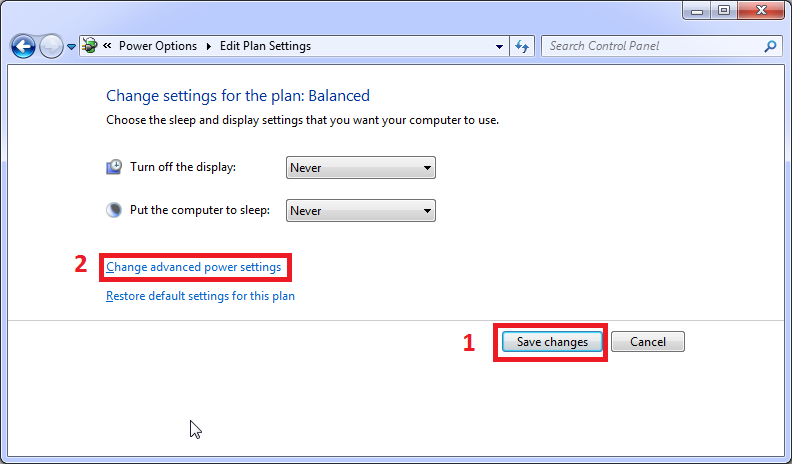
Power Option Setting Window 3
-
In the pop-up window, you need to change the following to "Never"
-
Hard disk->Turn off hard disk after->Setting (Minutes) ( Figure B.5)
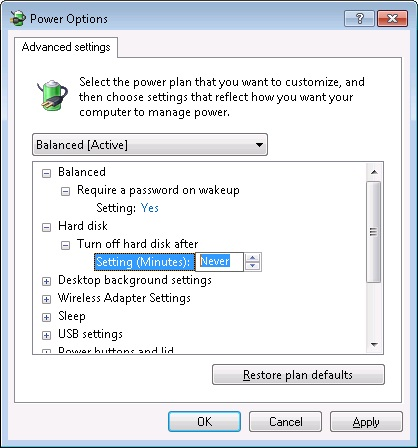
Setting Hard Disk Turn Off Time
-
-
-
Sleep->Sleep after->Setting (Minutes) ( Figure B.6)
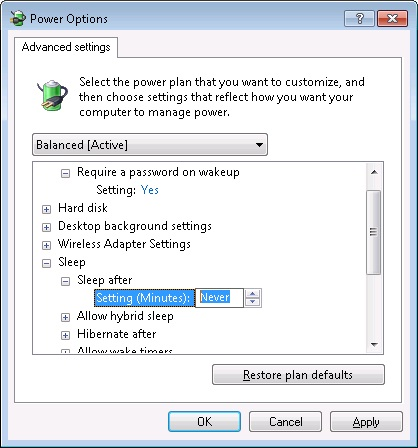
Setting Sleep Time
-
Sleep->Hibernate after->Setting (Minutes) ( Figure B.7)
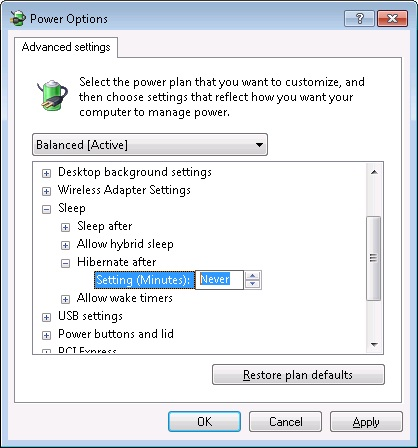
Setting Hibernation Time
-
Downloading QUARC
For situations where online installation is not possible or not desired (e.g. labs that do not have Internet access). It is possible to download QUARC using the QUARC web installer on a PC that has Internet access, and then install QUARC using the downloaded files.
Depending on whether you have a single-user license or network license, you should:
-
Single-user license: Following the installation instruction in Section 5.1 up to and including step 10. However, at step 9, select all the features that your license is entitled to.
-
Network license: Following the installation instruction in Section 5.2.1 up to and including step 9. However, at step 9, select all the features that your licsense is entitled to.
Instead of choosing "Install" after the above step, you can choose "Download" from the dropdown button next to "Install", as depicted in Figure C.1. This will download all the features that have been selected on the page.
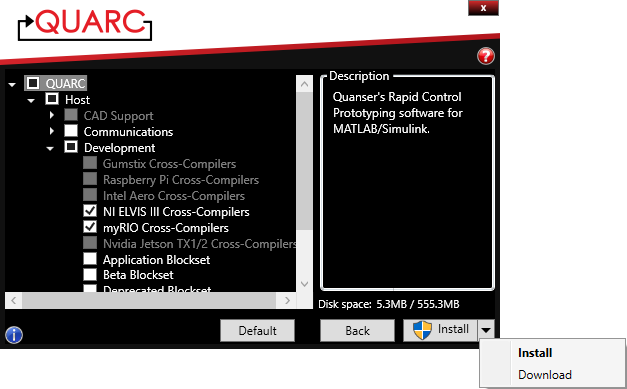
|
|
Feature Selection Download Page |
A dialog window would show up for selecting the folder to download the installer, as depicted in Figure C.2. Select the folder (or create a new folder) to download the installer, then press "OK".
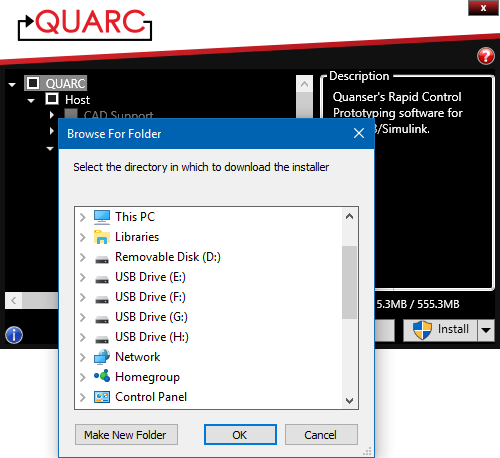
|
|
Feature Selection Download Folder Selection |
Once the download is complete, the installer would indicate that the installation disk is ready to be used, as depicted in Figure C.3.
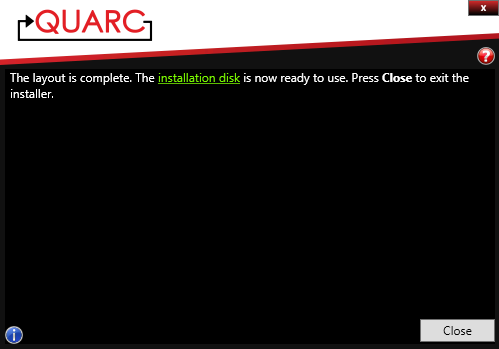
|
|
Feature Download Complete Page |
To install from the downloaded QUARC, simply run the install_quarc.exe in the directory as indicated in the installation disk and follow the same instructions as depicted in single-user or network license sections, and choose "Install" instead of "Download".
Enabling 8.3 path name
For situations where desired install location is not on a system drive (usually C:), it is recommended to enable short path name.
The following steps will enable a drive (in the following steps, replace <drive> with actual drive letter) to support short path name:
-
Open a Command Prompt with Administrator privileges (right-click on Command Prompt icon after finding it in the Start menu and select "Run As Administrator").
-
Enter the following command to enable per-volume 8.3 path names:
fsutil 8dot3name set 2 -
Enter the following command to enable 8.3 path names on <drive>
fsutil 8dot3name set <drive>: 0
Extra steps are required if the desired install location is under an existing directory with space on the drive that did not have 8.3 path name enabled (e.g. the desired install location is under <drive>\Program Files\Quanser), then the following steps will need to be performed:
-
Reboot the computer into Safe Mode (hold down Shift when pressing the Power button and select Restart. Then when it reboots, select "Startup options/Advanced" and press Restart. After restarting, select "Enter safe mode".
-
Once in safe mode, open a Command Prompt with Administrator privileges and enter the command (note that you will need to repeat the following steps if the desired install location is under multiple sub folders that have spaces):
fsutil file setshortname "<drive>:\<folder with space>" <short name>Replace <drive> with the actual drive letter. Replace <folder with space> with the folder that has space in it. Replace <short name> with a string that has 8 or less characters. For example if <folder with space> is "Program Files", it is recommended that <short name> be "PROGRA~1" to be consistent with what Windows will automatically generate.


QUARC™ - A Decade in the Making
QUARC is built on the legacy of WinCon, Quanser's first real-time software to run Simulink®-generated code under Windows. QUARC seamlessly integrates with Simulink and takes the traditional design-to-implementation interface toolset to new levels. With just the click of a button, you can enjoy more functionality and more development flexibility, all geared towards improved real-time performance. QUARC has been successfully deployed in many advanced control and mechatronic platforms ranging from intelligent unmanned systems to force feedback-enabled virtual reality.
Designed by engineers for engineers, QUARC significantly accelerates the control design and implementation process. That's why QUARC software is an integral part of all Quanser control lab systems and solutions. Thousands of educators and researchers worldwide trust QUARC for rapid control prototyping.
Whether you use QUARC for teaching, exploration, or innovation, you'll spend more time designing, less time coding.

